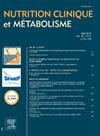COVID-19 et obésité : quel rôle du tissu adipeux ?
IF 0.5
4区 医学
Q4 ENDOCRINOLOGY & METABOLISM
引用次数: 0
Abstract
In March 2020, coronavirus disease 2019 (COVID-19) caused by SARS-CoV-2 was declared a global pandemic by the WHO. Obesity was rapidly identified as an independent risk factor for poor prognosis, with an increased risk of acute respiratory distress syndrome, cardiovascular and thrombo-embolic events, admission to intensive care and mortality. The white visceral adipose tissue, which increases in people suffering from obesity, appears to have a key role in this pathogenesis, as it constitutes a viral reservoir for SARS-CoV-2 through angiotensin 2-converting enzyme receptors. Following infection of host cells, activation of pro-inflammatory cytokines creates an environment suitable to the ‘cytokine storm’ and macrophage activation syndrome, associated with a risk of progression to acute respiratory distress syndrome. In obesity, the systemic spread of the virus, its entry and prolonged excretion into already inflamed adipose tissue can stimulate immune responses and the subsequent amplification of a cytokine cascade, worsening the course of the disease. The endothelial hyperactivation induced by SARS-CoV-2 combined with the state of hypofibrinolysis and endothelial dysfunction present in obesity increases the risk of thrombo-embolic events. The volume of visceral and epicardial adipose tissue measured by CT scan appears to be a good prognostic marker for these unfavorable outcomes. In addition, vaccine responses appear to be lower in these patients due to a weaker early humoral response, which means that prevention messages need to continue to be disseminated and booster vaccinations encouraged in this population. The aim of this review is to determine the role of adipose tissue in the poor prognosis of obese patients infected with SARS-CoV-2.
© 2023 Société francophone nutrition clinique et métabolisme (SFNCM).
Published by Elsevier Masson SAS. All rights reserved.
COVID-19与肥胖:脂肪组织的作用是什么?
2020年3月,世界卫生组织宣布由SARS-CoV-2引起的冠状病毒病2019 (COVID-19)为全球大流行。肥胖迅速被确定为预后不良的独立危险因素,与急性呼吸窘迫综合征、心血管和血栓栓塞事件、入住重症监护和死亡的风险增加有关。在肥胖人群中增加的白色内脏脂肪组织似乎在这一发病机制中起着关键作用,因为它通过血管紧张素2转换酶受体构成了SARS-CoV-2的病毒库。在宿主细胞感染后,促炎细胞因子的激活创造了一个适合“细胞因子风暴”和巨噬细胞激活综合征的环境,这与进展为急性呼吸窘迫综合征的风险相关。在肥胖中,病毒的全身传播、进入和长时间排泄到已经发炎的脂肪组织中,可以刺激免疫反应和随后的细胞因子级联扩增,从而恶化疾病的进程。由SARS-CoV-2诱导的内皮细胞过度激活,加上肥胖患者的低纤溶状态和内皮功能障碍,增加了血栓栓塞事件的风险。CT扫描测量的内脏和心外膜脂肪组织的体积似乎是这些不良结果的良好预后指标。此外,由于早期体液反应较弱,这些患者的疫苗反应似乎较低,这意味着需要继续传播预防信息,并鼓励在这一人群中加强疫苗接种。本综述的目的是确定脂肪组织在感染SARS-CoV-2的肥胖患者预后不良中的作用。©2023法国社会组织(SFNCM)。Elsevier Masson SAS出版。版权所有。
本文章由计算机程序翻译,如有差异,请以英文原文为准。
求助全文
约1分钟内获得全文
求助全文
来源期刊

Nutrition Clinique et Metabolisme
医学-内分泌学与代谢
CiteScore
0.80
自引率
16.70%
发文量
216
审稿时长
78 days
期刊介绍:
Nutrition Clinique et Métabolisme is the journal of the French-speaking Society of Enteral and Parenteral Nutrition. Associating clinicians, biologists, pharmacists, and fundamentalists, the articles presented in the journal concern man and animals, and deal with organs and cells. The goal is a better understanding of the effects of artificial nutrition and human metabolism. Original articles, general reviews, update articles, technical notes and communications are published, as well as editorials and case reports.
 求助内容:
求助内容: 应助结果提醒方式:
应助结果提醒方式:


